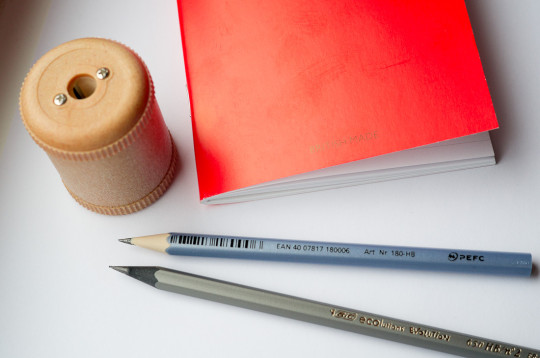 Today: another pencil from France. This time it’s an eco pencil, the BIC ecolutions evolution BLACK. It’s a really good looking eco pencil with gold lettering on a dark grey, slightly metallic looking body. I paid £1.49 (~$2.35; €1.80) for a set with four pencils from a local supermarket.
Today: another pencil from France. This time it’s an eco pencil, the BIC ecolutions evolution BLACK. It’s a really good looking eco pencil with gold lettering on a dark grey, slightly metallic looking body. I paid £1.49 (~$2.35; €1.80) for a set with four pencils from a local supermarket.
When I first saw the packaging I was sceptical – it looks good, but does it write well? Most eco pencils don’t write very well, with the Wopex and paper-rolled pencil being the only exceptions I find usable.
Similar pencils
“Relatives” of this pencil have been reviewed at pencil talk and Lexikaliker. Unsurprisingly the BIC ecolutions evolution BLACK seems to be very similar to these pencils. The box indicates that it’s made form 55% recycled material and looking closer this seems to be an extruded pencil with an aerated casing. The pencils seem to have more air bubbles in the centre of the body, near the lead.

The sharpener used
I thought an eco pencils deserved a suitable sharpener, so I tried out the Dux Bio, a sharpener being advertised as 100% compostable and made from 80% renewable resources – even though I think it might be biodegradable rather than compostable, i.e. it the sharpener probably doesn’t turn into humus .
A quick word about the Dux Bio, also known as the DX5907. It’s a great sharpener that produces an even point with an angle of ~24°, even on difficult to sharpen pencils. I actually tried to get my hands on one for a while, but wasn’t able to find it anywhere. In the end (about 18 months ago) Dux was kind enough to send me one.
Using this pencil
Sharpening this pencil is fairly easy for a pencil with a body made from recycled material other than paper. The graphite core looks similar to that of a traditional pencil, but when looking at a sharpened point the graphite seems to be more reflective. 
The BIC ecolutions evolution BLACK produced a fairly light line – so light that it is tempting to press harder, especially if the point has been used for a while and the line is wider. Unlike a more traditional pencil pressing harder doesn’t however result in a darker line – or should I say the causal relation between pressing harder and producing a darker line is not as obvious as it is with a normal pencil.
Conclusion
Overall it’s not bad for a recycled pencil. It’s certainly much better than the recycled pencils made by Remarkable, but even though it’s easy to sharpen it doesn’t produce a line as good as the Wopex.
Price and exchanges rates: September 2013



What a beautiful pencil!
I finally got to try the greenish version recently, andI like this model very much, perhaps especially because it is actually made in France (none of Bic’s other current wooden pencils are, I think…?). The fit of the ferrule/eraser is very well-done, and the finish is very fine. The black is perhaps even nicer looking. 🙂
Except the black and green version there’s also a colourful version. I bought it many months ago, but never got round to trying it out.
I also like the fact that they are made in France, I just wish the lead was a bit better.
I bought a four-pack of these with a turquoise barrel and wood-ish coloured centre for £1 in Poundland the other day. They’re eraser tipped, and I really quite like them. They sharpen fine in my Carl Angel, which is something I could never get the Wopex to do. With a really acute point, the lead actually flexes if you put pressure on it! The plastic/graphite composite core has the same kind of smudge-resistance as the Wopex.
One unusual thing about it is that there’s a thin yellow sheath or coating around the ‘lead’ core. I’ve posted a picture here. I’m not sure why there’s a yellow sheath around the lead, but presume it serves some kind of purpose?